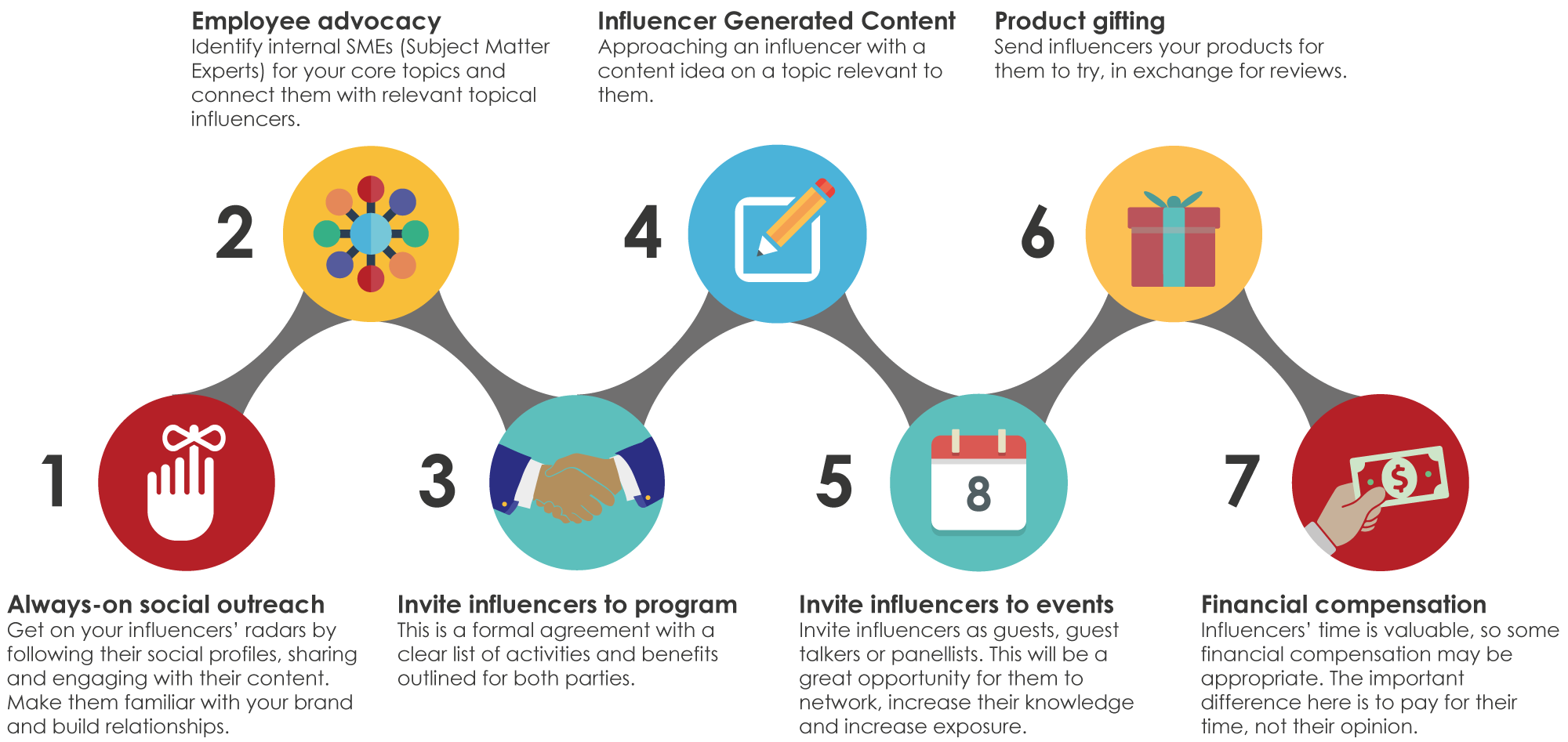Influencer engagement is the most challenging part of Influencer Relationship Management. It requires a PR culture of building 1-to-1 relationships with a marketing activation of scaling engagement with a 1-to-many model. An added challenge is that there’s no one size fits all approach. How you engage with your influencers depends on variables such as the type of influencer you’re engaging with; what both the influencer and the brand seek to gain; if there’s any existing activities you can tie influencer marketing into, and whether your focus is more geared towards product or content.
If we look at the engagement approaches as being on a spectrum ranging from truly organic to paid, content will come within the organic range, whereas product is more likely to be closer to paid. This is extremely applicable for B2C brands with a low value product on offer, who pay high profile influencers to endorse their products on Instagram posts to their followers.
In this post we are going to outline 7 engagement models, what they entail and when they’re appropriate.
1. Always-on community social outreach
What?
This approach really embodies what true influencer relationship management is all about. Make your influencers familiar with your brand before you even approach them to work together by having an always-on approach. What we mean by ‘always-on’ is that this is a consistent, long term approach, rather than a campaign mentality. Follow your influencers’ (both your engagement targets and the wider influencer community) social profiles and engage with their content. This includes topical content and general content too to build rapport.
Why?
Always-on community social outreach works very well when a brand is targeting micro influencers, as they’re far more likely to engage back. This engagement model is also important in terms of general social media presence and brand awareness by engaging in relevant topical conversations and engaging with customers.

“We try to have Twitter and email conversations that go beyond Adobe. You also have to share the work they do and have a personal exchange. it’s a real give and take.”
Joe Martin, Global Strategic Marketing, Adobe
2. Employee advocacy
What?
Identifying internal SMEs (Subject Matter Experts) for each of your core topics and connecting them with relevant topical influencers so that they’re able to build and nurture relationships.
Why?
This allows you to effectively scale up and build organic relationships with multiple influencers in a feasible way. This approach, for the lack of a better phrase, kills two birds with one stone. Influencers will be far more receptive if they’re approached by a personal account over a branded account. This is also a great opportunity to build your brand awareness and employees’ personal brand too. This does not need to be too taxing on your employees’ time either. Track your wider influencer community’s social conversations on specific program topics and interact with them whenever they post relevant content. This reactive contextual engagement will provide the engagement hooks that you need to start or continue conversations with the community.
3. Invite influencers to join your program
What?
This is a formal agreement where you contact an influencer with a proposal for them to join your program. Within this invitation it is clearly outlined what is expected of them if they accept their invitation to the program, as well as the benefits that they seek to gain. It is important that these benefits are well thought out and attractive to each influencer.
Why?
This works well when you’re working with a few influencers and have a clear value proposition for your influencer, as well as a very clear objective/end goal. For example: inviting influencers to a program in which they create some thought leadership content, in exchange for early or exclusive access to your product.
4. Influencer Generated Content
What?
This entails approaching an influencer with a content idea that you can collaborate on. This could take the form of a blog post, interview, webinar or podcast. To ensure that you’re posing an attractive opportunity, it is important that you conduct research beforehand to gauge a good idea on the type of content they produce and the topics they seem to be most passionate about, or wanting to increase their influence in. This level of engagement can be touch point one if your brand is reputable enough in the industry, or it can come later down the line after multiple touch points with the influencer.
Why?
Approaching them with a content idea that is a great opportunity for them to gain exposure to a new audience, provide value to their existing audience and demonstrate their expertise. This will also diversify your content, increase your brand exposure and help you build a relationship with the influencer.
5. Invite influencers to your event
What?
If you have an upcoming event, invite your influencers along either as a guest or to be on a panel/give a talk. So long as the event is relevant, this is a valuable opportunity for the influencer.
Why?
Inviting them as a guest enables you to meet in person and build a relationship; they can also share live updates and key takeaways on social media (which is great exposure for your brand + content for their audience) improve their knowledge and expand their network. Offering exclusive influencer only access and talks also provides added value. Inviting them to give a talk or be on a panel will offer the influencer an opportunity to gain exposure and highlight their expertise. Building a relationship with an influencer is also far easier to achieve if you meet in person. Get prepared now by assessing and pinpointing appropriate upcoming events.
6. Product gifting
What?
Giving your influencers free access to your product for them to try in exchange for a review or a mention on social media.
Why?
This gives the influencer intelligence on what’s available in the market place, which they can pass on to their audience. They’re also able to provide a genuine non-scripted testimonial on your brand. This engagement model works particularly well in the B2C space where products are more likely to be physical. This can however still work and be effective in B2B with software and services being your product.
This could entail giving a demo and free access to the influencer purely for knowledge or to help them with their personal or professional brand.
7. Financial compensation
What?
Financial compensation entails paying an influencer to work with you. This could be paying for them to mention your brand in a sponsored post (commonly seen in B2C on Instagram and YouTube) or purely to pay for their time (e.g. for a B2B influencer to write a whitepaper).
Why?
Some influencers earn their living through being an influencer, so financial compensation may sometimes be necessary as influencers’ time is valuable, but should not always be the first or sole approach. Some influencers will initially work with you for free, but start to charge once more of their time is needed. Many influencers look to build a relationship with brands first before they even work with them, regardless of if they pay or not. The key is to pay for your influencers’ time, not their opinion.
If you’re looking to expand your knowledge on influencer marketing, download our whitepaper: The Definitive Practical Guide to Influencer Relationship Management by clicking on the button below.

DOWNLOAD NOW!
TAGS
DEFINITIVE PRACTICAL GUIDE TO INFLUENCER RELATIONSHIP MANAGEMENT
Download this free white paper including guidance and frameworks, that takes you through the whole influencer marketing process, in a practical and actionable way.

